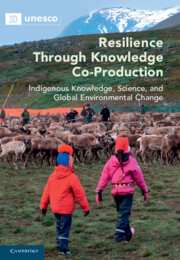 Resilience through Knowledge Co-Production
Resilience through Knowledge Co-Production from Part I - From Practice to Principles
Published online by Cambridge University Press: 02 June 2022
In recent years, reductions in Arctic sea ice extent and thickness have been most pronounced in the Pacific Arctic sector. In addition to major losses of summer ice in the Chukchi Sea, the Bering Sea ice cover transitioned from above-normal winter ice extent to near complete absence of sea ice in winter in a few years. We highlight observations and findings by Kifikmiut sea-ice experts from the community of Wales in the Bering Strait, Alaska. These observations and the Indigenous knowledge in which they are embedded provide insights into sea-ice change from the perspective of ice users intimately familiar with the cultural landscape of sea ice and its important role in the coastal environment. Our collaborator, the late Winton Weyapuk, Jr., in particular, was instrumental in helping establish a coastal community Indigenous observer network in 2006 during the International Polar Year that radiated out from Wales and continues to grow and thrive. We compare the seasonal sea-ice cycle based on Mr. Weyapuk’s observations for the ice seasons of 2006/07 and 2015/16, illustrating the importance of sea ice for coastal Alaska communities and discussing key aspects of ice-cover demise and its impacts.
To save this book to your Kindle, first ensure [email protected] is added to your Approved Personal Document E-mail List under your Personal Document Settings on the Manage Your Content and Devices page of your Amazon account. Then enter the ‘name’ part of your Kindle email address below. Find out more about saving to your Kindle.
Note you can select to save to either the @free.kindle.com or @kindle.com variations. ‘@free.kindle.com’ emails are free but can only be saved to your device when it is connected to wi-fi. ‘@kindle.com’ emails can be delivered even when you are not connected to wi-fi, but note that service fees apply.
Find out more about the Kindle Personal Document Service.
To save content items to your account, please confirm that you agree to abide by our usage policies. If this is the first time you use this feature, you will be asked to authorise Cambridge Core to connect with your account. Find out more about saving content to Dropbox.
To save content items to your account, please confirm that you agree to abide by our usage policies. If this is the first time you use this feature, you will be asked to authorise Cambridge Core to connect with your account. Find out more about saving content to Google Drive.